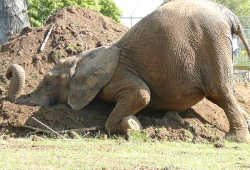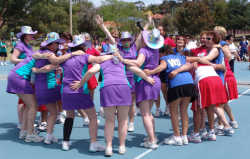Part 17 – More About Life In New Zealand During World War 2 Dorothy – 04/05/01
Since the publication of earlier articles in this series about life in New Zealand during World War 2, readers have supplied me with additional information about two aspects mentioned earlier – the work of the Navy League and the growing of linen flax.
Navy League spinners and knitters in Dunedin Margery Blackman, well known Dunedin weaver, textile curator and conservator, recalled reading that during World War 2 some of the women of the Navy League in Dunedin knitted for the navy.
An extract from an article by the late May Kirkpatrick printed in “The Web” in June 1979, describes their activities.
“Very soon after the outbreak of World War II a group was formed to knit for the Navy. A little later it became a spinning group, ultimately mainly producing wool for sea boot stockings.”
May was a member of the group but as she was teaching south of Dunedin at Kaitangata, she did her spinning there.
May continues, “A long time later I learnt from a wearer in the Navy just what a help these had been. They were coarsely spun and closely plied and knitted in the grease.
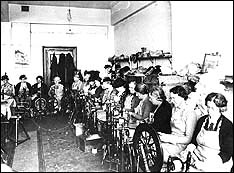 |
| Spinners at work Click here for a larger version |
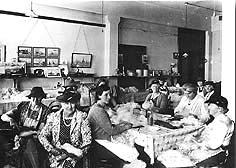 |
| Women sorting, hackling and carding the wool Click here for a larger version |
“The photographs belong to Jean Double, of Christchurch, whose mother, Mrs A. H. McCurragh, was a member of the group. They were taken in the large room at the top of the New Zealand Express Company building in Dunedin about 1941. Spinning wheels lined the walls and at the central tables others sorted, hackled and carded the wool. Jean tells us that her mother had to hackle and card for a year before she was allowed to start spinning. Everyone was required to spin three sausages of the carded wool before they could used the hackled wool which was so much easier to spin. Farmers donated very good fleece and nothing was wasted.”
May comments that hats were probably kept on because there was nowhere to put them. All the women spinning wore aprons and slippers.
Spinning became increasingly popular. May also recalled that weaving was taught at the special school at Otekaike in North Otago and became very popular. Along with knitting with commercial wool, spinning became the school’s major war project. Local farmers supplied the wool, some boys carded and others spun and plied.
Growing linen flax Jessie Dodd supplied the accompanying photo of the Gore High School pupils harvesting linen flax during the second world war. Her husband and brother recently researched the topic, and found in the New Zealand Geographic an article “The Linen Years” by Mark Bathurst (Number 42, April/June, pages 46 and 47). This gave more information about the linen flax industry during World War 2.
Linen essential to Britain for the war effort The urgency for the production of linen was that it was used as fuselage and wing fabric for aircraft such as Mosquito fighters and Wellington bombers which had largely wooden frames. Linen was also used for fire hoses, parachute webbing and heavy-duty canvas. Once the Germans occupied the Netherlands and Belgium, which were major producers of linen, the British ran short of supplies and asked a number of other countries to produce linen.
Linen flax grown in New Zealand The British Government was so concerned about the linen shortage that in 1939 it offered the finance for a linen flax industry. At first this finance depended on the farmers growing 6000-odd hectares, but it was not long before the British Government requested it be increased “to the uttermost limit”. For the industry to be established New Zealanders had to build the machinery and set up factories. Seventeen factories were built at various locations in the South Island east of the Southern Alps.
As flax fibre is highly flammable the factories had strict fire precautions and because of their importance to the war effort they were designated “Protected Places” and guards were on duty day and night. To staff the factories retired men went back to work, and jobs were taken by unemployed people and married women who had been expected before the war to be full time homemakers. To fill the remaining vacancies people were also manpowered to work in the factories under the Industrial Man-Power Act.
Seed from Britain was used for the first planting, but after that farmers sowed seed from the local crops. The plants were pulled from the ground, usually by machines, and bound into sheaves, which were taken to the factory and weighed. Next the seeds were removed by machine and kept for the next season’s planting or sent to factories where they could be pressed to make linseed oil, used in the manufacture of paints and varnishes.
Once the seeds were removed the flax was soaked in retting tanks of hot water so that the outside covering of the stems would rot. After a few days the sheaves which now smelt most unpleasant were spread out on paddocks to dry. Finally the sheaves were beaten in a machine, in a process termed
scutching. This removed any waste material, and the fibre was ready to be baled for export to Britain. Any fibre which was damaged was made into tow for the manufacture of string and rope in local factories.
Very taxing work It is no wonder that people had to be manpowered to fill the vacancies in the factories because the work was exhausting and most unpleasant with the air full of dust or steamy and evil-smelling, depending on where in the factory people worked. The fibres damaged the skin on the women’s hands if their job was to comb the flax by hand.
The patriotic spirit prevailed Some farmers lost money by growing linen flax and the workers disliked the demanding work in the smelly factories. However, like most Kiwis of that time, they accepted these problems as their part of the war effort.
People from Gore harvest a crop by hand On one occasion on the farms near Gore there were no machines available to pull the flax and it was feared that wintry weather, even snow, might set in before the crop was harvested. Five hundred people from Gore volunteered to harvest 100 acres of flax by hand. It took ten days of unremitting toil from dawn to dusk to complete the task. The workforce included school pupils.
It was during this time that the photograph was taken of the Gore High School pupils helping with the harvest.
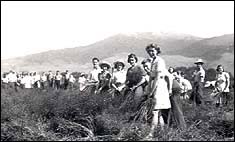 |
| Secondary school pupils from Gore in Southland in 1942 pulling flax Photo source Jessie Dodd Click here for a larger version |
Working on the Sabbath In those days of strict Sabbath observance some people were upset by the workers carrying on the task on Sundays, so the Salvation Army Band was transported out to play hymns and soothe the troubled consciences of those who believed in strict Sabbath observance.
Prohibition area! This was a prohibition area at that time, but whisky was brewed in illicit stills in the Hokonui Hills. Bottles were brought by some of the owners and the glow of the whisky kept up the energy of those willing to drink it.
The flax industry short-lived The linen flax industry continued in a few places after the war but the last factory, which was in Geraldine, closed in 1977.
Related Articles
- Part 13 – School pupils’ memories, the Home Guard, the mystery object in the sea, the Navy League, defence measures in Lyttelton Harbour
- Part 14 – More about life in New Zealand during World War 2 – stringent defence measures
- Part 15 – Restrictions on travel, rationing, different roles for women.
- Part 16 – Serving overseas in World War 2

